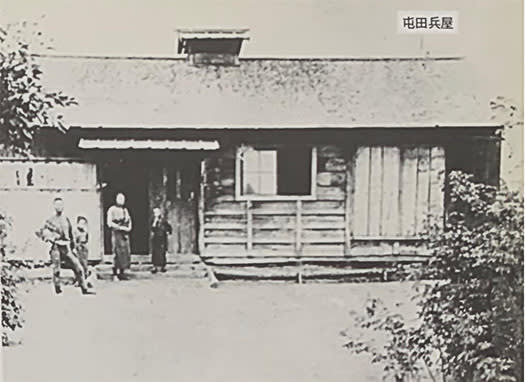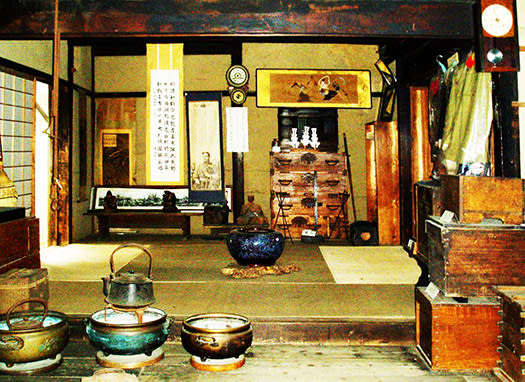


わたしの札幌の高校時代の友人たちには「屯田兵の子孫」という存在もいる。いまの札幌市西区役所のあたりには屯田兵の指揮所のような建築があったとも言われている。また、隣接して「琴似神社」があって、屯田兵のなかの宮城県出身者が中心になって勧請されたとも聞いている。
司馬遼太郎さんの「街道をゆく」シリーズの「北海道の諸道」には、旭川地域の屯田兵屋について触れているくだりがあってその組織形態の「軍隊組織」ぶりについて否定的に記述されている。氏の第2次大戦での陸軍経験から、内面から絞り出るような感情もあって、そのような記述になっていたのだと思うけれど、現実に屯田兵の「定着率」、兵役が明けたあとに地域に残った人びとというのは2割程度だった記録もあるとされていた。
旧軍的な組織原理が支配していたことでさまざまな桎梏はあったのだと思う。
写真は明治初年の屯田兵屋の様子と、わが家近くの琴似神社境内に残っている屯田兵屋・内部写真なのだけれど、正面の床の間には明治帝の肖像画が掛けられている。自発的にそういう肖像画をかかげるということは、あんまり想定できない。
日本人の感覚から言えば、床の間に飾りたいのは、家系の伝承とか由縁のような「父祖伝来」のという画像か、もしくは一般的には神仏にまつわる信仰の対象画像だろう。
そして屯田兵屋の建築造作もまた、この寒冷気候のなかにひとびとを投入するには貧寒に過ぎていた。とくに屋根は杮葺きで東北の民家が重厚な萱葺きで「断熱」を考えていることを参照せず、寒さへの防御力がほとんど見られない。
それでも明治の初年の日本社にあって開墾して農地が確保できて家が持てるというのは、民にとって魅力的ではあったのだろう。しかし日本の家屋の性能上の「伝統」とは、「雨露をしのぐ」性能だけだったのではとも思える。その基本の上に、精神文化としての「わびさび」のような要素が加わって、その要素を持って「高級の住宅文化」としてきた様子がわかる。
言ってみれば寒さへは目をつぶって、精神としての深淵ぶりを誇示するという「やせ我慢」文化を強いていたと言えるのだろう。
アメリカの西部開拓における住宅の工法進化ぶりとは比較にならない貧寒さ。
結局、本格的な住宅の防寒対策は戦後になってようやく本格化していった。北欧・北米との本格的な技術交流があって、日本の住宅技術に革命がもたらされていった。
今日に残る屯田兵屋からはそういう歴史経過をみるような思い。今日の北海道人にとっても、「ルーツ感」とはほど遠い印象を持って受け止めている。
English version⬇
About 150 years ago, a Tondenbeiya cultivated land near my house.
In peacetime, they cultivated farmland, and in the southwest, they went to war as far away as Kagoshima. The Tonden Troop House was built 150 years ago near our house. ・・・
Some of my high school friends in Sapporo are "descendants of Tondenbei. It is said that there was a building around the current Sapporo Nishi Ward Office that looked like a command post for the Tondenhei. The Kotoni Shrine is also said to have been built adjacent to the Tondenhei Shrine, and it is said that the shrine was built by a group of Tondenhei soldiers from Miyagi Prefecture.
In "Hokkaido's Roads" in Ryotaro Shiba's "Kaido yuku" series, he mentions the Tondenbeiya in the Asahikawa area and describes them negatively for their "military organization" style. He wrote negatively about the "military organization" of the Tonden-byo in the Asahikawa area.
I believe that there were various fetters due to the dominance of the old military-like organizational principles.
The photo shows the Tondenbeiya in the first year of the Meiji era and the interior of the Tondenbeiya that remains in the premises of Kotoni Shrine near my house. It is not very likely that such a portrait would be voluntarily hung in the alcove.
From the Japanese point of view, what one would want to display in an alcove would be an image of "ancestral heritage," such as a family tradition or a family history, or an image of a deity or an object of faith related to Shintoism and Buddhism.
The architecture of the Tonden-biya was also too cold for people to live in this cold climate. In particular, the roofs were shingled, which is not in reference to the heavy thatch of minka houses in the Tohoku region, where "heat insulation" is considered, and there was little protection against the cold.
Still, it must have been attractive for the people to be able to cultivate land and secure farmland and have a house in Nihon-sha at the beginning of the Meiji era. However, it seems to me that the only "tradition" in terms of performance of Japanese houses was their ability to "keep out the rain and dew. On top of this, there is an added element of "wabi-sabi" as part of the spiritual culture, and it is clear that this element has been part of the "high-class housing culture.
In other words, it can be said that they were forced to be "patient" in order to show off their spiritual profundity while turning a blind eye to the cold.
The coldness of the housing was incomparable to the evolution of housing construction methods in the western frontier of the United States.
In the end, it was not until the postwar period that full-fledged measures to protect homes from the cold began to take hold. The full-scale technological exchange with Northern Europe and North America brought about a revolution in Japanese housing technology.
The Tondenbeiya that remains today is a reminder of this historical process. Even today's Hokkaido residents have an impression that is far from a "sense of roots.









